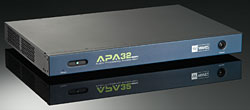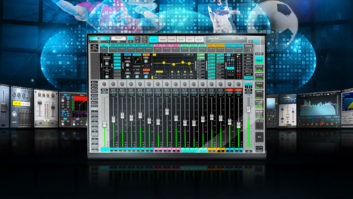
I love the quality and power that Waves plug-ins — such as the LinMB Linear Phase Multiband dynamics processor, LinEQ Linear Phase Equalizer and IR1 Convolution Reverb — provide. The downside is that these monster plugs consume a whale-sized portion of my computer’s CPU resources; just a few instantiations leave my dual 867MHz G4 nearly beached. The Waves APA32 Audio Processing Accelerator offers an elegant solution to this problem.
DESCRIPTION IN A “NETSHELL”
At the heart of the APA32 is Waves’ Netshell technology, which incorporates Ethernet-based hardware and software, letting the APA32 power Waves’ plug-ins running on a host computer. Each of the two Netshell hardware products can connect directly to your computer’s Ethernet port using a supplied “crossed” Ethernet cable.
I reviewed the APA32 ($1,600), a 1U rackmountable box suitable for use in machine rooms. Also offered is the APA44-M ($2,400), a quiet, portable and more powerful half-rack unit (for which a rackmount adaptor kit is available). You can mix and match, connecting up to eight units to an Ethernet switch (not a hub) using standard Ethernet cables. Waves recommends connecting APA units using a dedicated 1,000Mbps Ethernet adaptor in the host computer to avoid network conflicts and bandwidth shortfall. A stack of APA units can be shared by two or more Netshell-enabled host computers on the same network, although a single APA box cannot be shared by multiple computers.
The Netshell system and APA32 can’t power host-based Waves Version 5 plug-ins; they can only power Netshell-enabled versions. (Fourteen Netshell plugs are available.) APA32 users who don’t already own V. 5 plugs must download V. 5.2 installers for all of the plug-ins or bundles they wish to buy; existing Waves V. 5 users must also download the installers to get duplicate Netshell-compatible versions of the host-based Waves plugs they already own. This is an update process only and does not require additional purchase or reauthorizations. After installation, Netshell plugs appear in your DAW’s plug-in menu with a “Net” suffix appended to their otherwise familiar names.
The APA32 and V. 5.2 Netshell are Mac- and PC-compatible. Visit Waves’ Website for minimum system requirements and compatible DAWs. I used my dual 867MHz G4 with 1.8GB RAM for this review using one APA32; a faster machine is needed to run several APA boxes at once.
HARD AND SOFT
The APA32 is a simple-looking box, featuring front and rear power switches, a power receptacle for the detachable AC cord and an Ethernet port. Connect the Ethernet port on the APA32 to that on your computer, power up and go!
The Netshell Monitor, an included software utility, provides useful feedback on Netshell’s performance (consumption of CPU resources, memory and network bandwidth), and lets you view and set the system’s inherent latency (which most modern DAWs automatically compensate for). Netshell intelligently manages system overhead in a multiple-APA setup, loading newly instantiated Netshell plugs on the APA with the most available CPU resources.
Netshell plugs look and behave just like their host-based counterparts and can be used simultaneously with them (or with any other brand plugs). I could save Netshell-enabled plug-in settings as both AudioUnits presets and as clippings in Digital Performer V. 4.6. However, I couldn’t open presets for a Netshell plug (e.g., TransX Multi Net) in its corresponding host-based Waves plug (TransX Multi). I also discovered that you can’t copy and paste parameter settings from a Netshell plug-in to its corresponding host-based Waves plug or vice versa.
I could apply LinEQ Broadband to 19 tracks at once before the APA32’s CPU was maxed out and wouldn’t let me instantiate any more Netshell plugs. Alternatively, I could apply Morphoder Net to a dozen tracks or open eight instances of either LinMB Net or IR-1 Net or five instances of SoundShifter Pitch Net before hitting the wall. Maxing out the APA32’s CPU also incurred an additional 7- to 20-percent load on my G4’s CPU, depending on the number of Netshell plugs instantiated and due to the resulting network traffic management imposed on the Mac by the APA32.
Digital Performer 4.6 automatically compensated for Netshell’s latency, and the small-form Netshell Monitor always floated in front of all of Digital Performer’s other windows so that it was conveniently visible. The Netshell submenu of plug-ins appeared just below the Waves submenu in Digital Performer’s mixer insert drop-down menu.
The APA32 is noisy and belongs in a machine room: Its built-in fan constantly ran. I measured 52dB SPL (A-weighted) one foot above the fan with my Radio Shack sound level meter. Thankfully, the supplied Ethernet cable is plenty long — roughtly 32.5 feet — to accommodate the APA32’s remote placement. (Waves’ APA44-M, which is reportedly nearly silent, is available for studio use.)
NET GAIN
Having the ability to open so many powerful Waves plugs at once on a project is a truly liberating experience and opens a lot of possibilities, particularly when mixing. At $1,600 list, the APA32 is reasonably priced. And for early adopters, it’s a downright steal, because for a limited time, the APA32 comes with IR1-L Convolution Reverb Light Net and Q-Clone Net plug-ins for free.
Waves, 865/909-9200, www.waves.com.
Mix contributing editor Michael Cooper is the owner of Michael Cooper Recording, located in beautiful Sisters, Ore.






